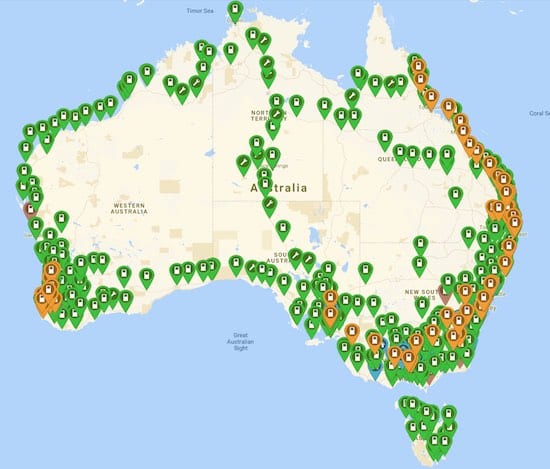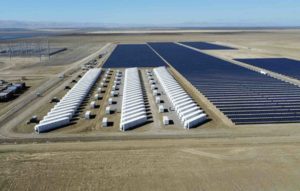UPDATED: A group of dedicated Tesla owners and drivers has built an electric vehicle charging network that spans Australia, providing any and all EV drivers with a usable charging route while they wait for governments and industry to catch up.
The Round Australia Electric Highway – pictured in the map on the right, above – covers a route around the nation of close to 17,000km, with charging outlets spaced a maximum of 400km apart, but in most cases an average of 200km, and no more than 300km.
The vast majority of the network – which was completed by May this year – uses 32 amp three-phase charge points (pictured below), which are able to be used by all types of EVs, using a 3 phase charging cable.
Those charging points offer a minimum available charge rate of 110km range per hour of charging, while some of the charge points ion the network that were pre-existing offer 70km of charge in one hour.
The idea behind the highway – which is an entirely voluntary initiative of the Tesla Owners Club of Australia (TOCA), with the costs of the chargers split between TOCA and the Australian Electric Vehicle Association – has been to fill the 10,000km of gaps where there are few or no EV chargers, including the Nullarbor, Stuart Highway and Top End.
In WA alone, more than 70 charge points were installed in towns and roadhouses on all major roads in the south and east of the state, as well as some remote locations in the north, with the backing of the state’s largest retailer, Synergy – as we reported here.*
The initiative, a team effort by Synergy and the WA branch of the Australian Electric Vehicle Association, is installing three-phase charge points in towns and roadhouses on all major roads in the south and east of the state, as well as some remote locations in the north.
WA’s regional utility, Horizon Power, also contributed to the roll-out, with installations of 3 phase outlets in the Kimberley area.
“We’re endeavouring to show that there is ‘people power’ behind the drive to EV’s, and hopefully governments can follow,” said Richard McNeall, a TOCA member and coordinator of the Round Australia Project.
“The Queensland government, so far, is the only state that has really thrown its weight behind EV charging,” he said.
Queensland’s Labor Palaszczuk government in January completed the first phase of its EV fast charging network – which is also, currently, free to use.
In that state, EV drivers can travel from Coolangatta to Cairns, and west from Brisbane to Toowoomba, using the government’s fast charger network, which is also vehicle agnostic.
Other initiatives happening around Australia include the installation of 50 dual EV chargers across government sites in Canberra, to support the ACT government’s planned shift to zero emissions government vehicles by 2022.
Tesla, meanwhile, is steadily adding to its supercharger network in Australia, with another 18 stations planned for the east coast in both metropolitan regions and along “popular holiday routes,” and one new charging station planned for Perth, Western Australia.
Tesla’s superchargers can provide drivers with half a charge in just 30 minutes, but are for use by Tesla’s only. On top of the superchargers, Tesla has more than 500 “destination chargers” installed throughout Australia, also only for Tesla drivers (although TOCA says they have been used to charge non-Teslas).
UK car maker Jaguar Land Rover has also announced plans to roll out a major charging network in Australia, ahead of the release of its first EV, the I-PACE all-electric SUV, later this year.
JLR Australia says the up to $4 million network would include 150 changing stations, using 100kW DC chargers provided by Jet Charge.
In most states, however, and at the federal government level, little to nothing of any substance is happening at a policy level to encourage the mass market uptake of EVs – a state of affairs that has put Australia well behind most of the rest of the developed world.
For the members of TOCA – who align themselves with Tesla’s mission statement, to accelerate the advent of sustainable transport by bringing mass market electric cars to market as soon as possible – the Electric Highway project is all about getting a usable EV charging route in place “right now.”
And not just for Tesla drivers.
“We are all keen to do something for the environment, and the more EVs the better,” said McNeall – the proud owner of “Tessie,” a blue Tesla Model S 90D 2016 which, he claims, was the first EV to drive around Australia without a support vehicle or mobile generator, and the first to drive across Australia via the “Red Centre” unsupported.
“Tesla has, up until now been the only company selling 300km+ range EVs, so it pretty well has had to be an all-Tesla effort,” McNeall told RE.
“Also most people doing this field work are members of the Australian Electric Vehicle Association, and AEVA is most definitely dedicated to an Electric Highway.”
McNeall says what EV drivers like him would like from the government include policies to remove all forms of fossil fuel subsidy; set regulations to taper down and ultimately remove fossil fuels as a transport fuel; incentives to encourage EV uptake as a direct climate action initiative; and incentives to get private operators into EV charging – among other things.
In the meantime, Australian EV drivers can find TOCA’s network of EV chargers on plugshare.com, which also shows all the other types of chargers installed around Australia.
And for those property owners or business owners wishing to get in on the EV charging loop, the offer remains open.
*This article has been updated to reflect that the Western Australian government, via state-owned retailer Synergy, contributed to the AEVA and TOCA roll-out of more than 70 EV charge points in rural and remote Western Australia.











